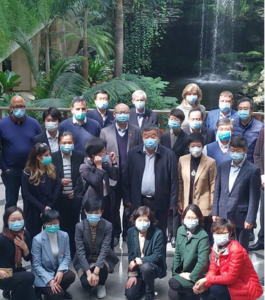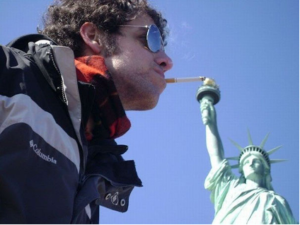The COVID Response. What We Got Wrong.
Part VI: The Masks

Photo of a WHO mission to China in 2020
At the beginning of the COVID crisis, in the early months of 2020, there was almost uniform agreement among scientists that the virus was an airborne pathogen – i.e., that, among other ways, it could be spread in the air. Thus, if public health officials had told us back then to mask up, it would have made sense to me.
But that wasn’t what we heard from the CDC. Instead, they said there was “no need” for us to wear masks. Yet, as you can see from the photo above, frontline workers were wearing them.
Several months later, the CDC reversed their position and began recommending masks. And soon after that, they became mandatory.
Why was that?
We know now that the CDC was concerned that there could be a shortage of masks available for frontline workers if the general public was masking up. And since frontline workers had a much greater chance of becoming infected, and since their work was, as described, critical to the health of the larger community, they decided they could best avoid such a shortage by claiming that the public should not be wearing masks.
I get that. As a public health policy matter, agencies like the WHO and the CDC are charged with protecting the public’s welfare – not, as some might suppose, with providing the “science” and letting individuals decide how to respond. That being the case, I can understand why they may have come to the decision to tell frontline workers to do one thing, while telling the public to do something else. The citizenry is too unthinking to sort through complicated issues like public health to make sensible decisions on their own. If you want compliance, it’s much more effective to tell them what you want them to believe, tell it from a position of authority, and repeat it X number of times until most of them believe it with every fiber of their non-thinking brains.
(By the way, I share the view that the public is too unthinking to make smart decisions about complicated things. I also agree that if you want large-scale compliance with almost any issue, the best way to do it is to create an emotionally compelling narrative, coated with attractive little white lies (or big black lies). Rinse and repeat. The difference between me and the CDC is that I think it is immoral and maybe even unconstitutional (What do I know? Constitutional law is complicated!) for the government to do that. What democratic governments should do – i.e., are morally bound to do – is spell out the facts, as they are known honestly, and allow the public to make decisions with as little rhetorical bullshit as possible.)
And perhaps, had the CDC and the government continued to repeat the inconsistent recommendation that frontline workers should wear masks but the public should not, the public might have believed it.
But then, on April 3, 2020, the CDC changed its position. Masks, they said, should be worn by the public. Three months later, 31 states had turned that recommendation into a mandate. And then in January 2021, one of the very first things Biden did as president was mandate masks for federal workers, government officials, and all citizens using federal buildings or on federal property (including outdoor spaces!).
This cured the inconsistency problem. But by that time, the CDC and other public health agencies had done a good bit of work on the efficacy of wearing masks and they knew that the typical size of the airborne COVID particles was so small that only the N95 masks were dense enough to be worth recommending. (They are called N95s because they can block 95% of the virus particles.) They also knew that, of the several types of masks, cloth masks were the least efficacious. In some studies, they were shown to have efficacy rates below 20%. Overall (I’m saying this from scanning all the studies I could find), the average efficacy was around 50%.
So, why didn’t they (the CDC, other health agencies, and the government) come out and tell us that? Why did they recommend masks generally?
I can think of three reasons:
- They may have believed that there weren’t sufficient N95 masks available to meet the surge in demand.
- They may have felt that if they recommended N95 masks, the government would have to pay for them because they were so much more expensive than cloth masks, and that would make compliance an issue.
- They didn’t want to come right out and admit that they were purposely misleading the public with their initial recommendation.
So, for more than two years, the CDC and our government (also WHO and most other governments) continued to promote the fake-science idea that cloth masks are effective.
And because that bit of misinformation was repeated ad nauseum, it worked. Most Americans came to believe that wearing a mask was not only a sign of intelligence, but also a sign of virtue. (You were protecting others.) And that not wearing a mask was a sign of ignorance and malfeasance. (Nancy Pelosi made an issue of this by fining Senate members that came to meetings maskless.)
Eventually, it became apparent that cloth masks didn’t work. People that wore them were getting COVID. And they were probably passing it on to others.
Aware that the truth was getting out, and worried about being exposed for their intentional misrepresentation of the facts, the CDC finally adjusted its position. In January of this year, its website was “updated,” acknowledging that cloth masks offer only limited protection. Of course, they didn’t come right out and tell the truth, the whole truth, and nothing but the truth. It was worded like this:
“Loosely woven cloth products provide the least protection, layered finely woven products offer more protection, well-fitting disposable surgical masks and KN95s offer even more protection, and well-fitting NIOSH-approved respirators (including N95s) offer the highest level of protection.”
The Bottom Line: Cloth masks were not effective against the original coronavirus, and they were even less effective against the highly contagious Omicron variant (which can be carried by much smaller droplets that can linger indoors for hours). Leana Wen, an emergency physician and visiting professor of health policy and management at the Milken Institute School of Public Health, put it this way: “Cloth masks are little more than facial decorations.”
The CDC should have done what Fauci kept insisting he was doing: reporting the latest studies and making recommendations that were based on those studies in a clear and transparent way. Instead, they began with what I’m sure they felt was a little white lie, but then were obliged to perpetuate that white lie for nearly three years.
And they did it while evidence was piling up that made their statements and pronouncements not just increasingly disingenuous, but also dangerous to the American public.
It would have been better for everyone if they had reported the “science” as it arrived and made transparent recommendations based on the latest data. Had they done it that way, they would have admitted that N95 and surgical masks were much safer than cloth masks. They would have said that if you could not get hold of or afford N95 masks to wear a combination of surgical and cloth masks. And they would have told us that social distancing was the best way to avoid contracting COVID and spreading it to others.
I don’t think all the misinformation about mask wearing did as much damage as, say, the stay-inside mandates. Not by a long shot. But it did damage to the credibility of the CDC and the government and the major media. The trust most of us had in these institutions is shaken. For some of us, it is gone.
 MarkFord
MarkFord








